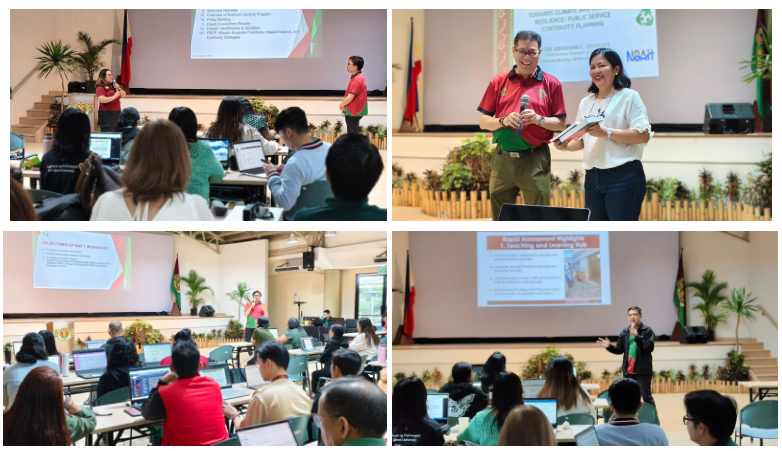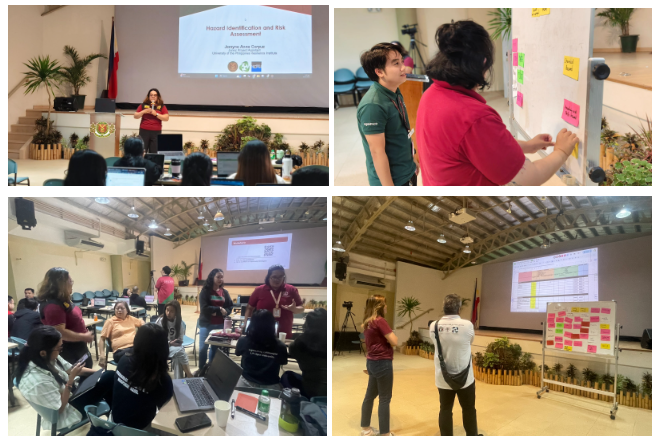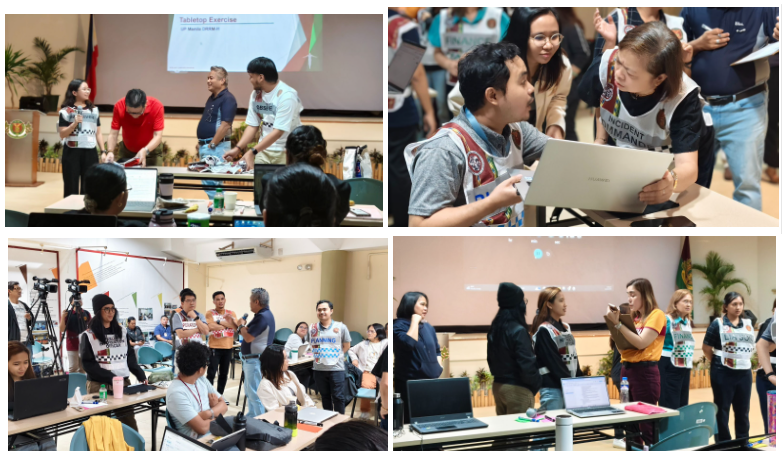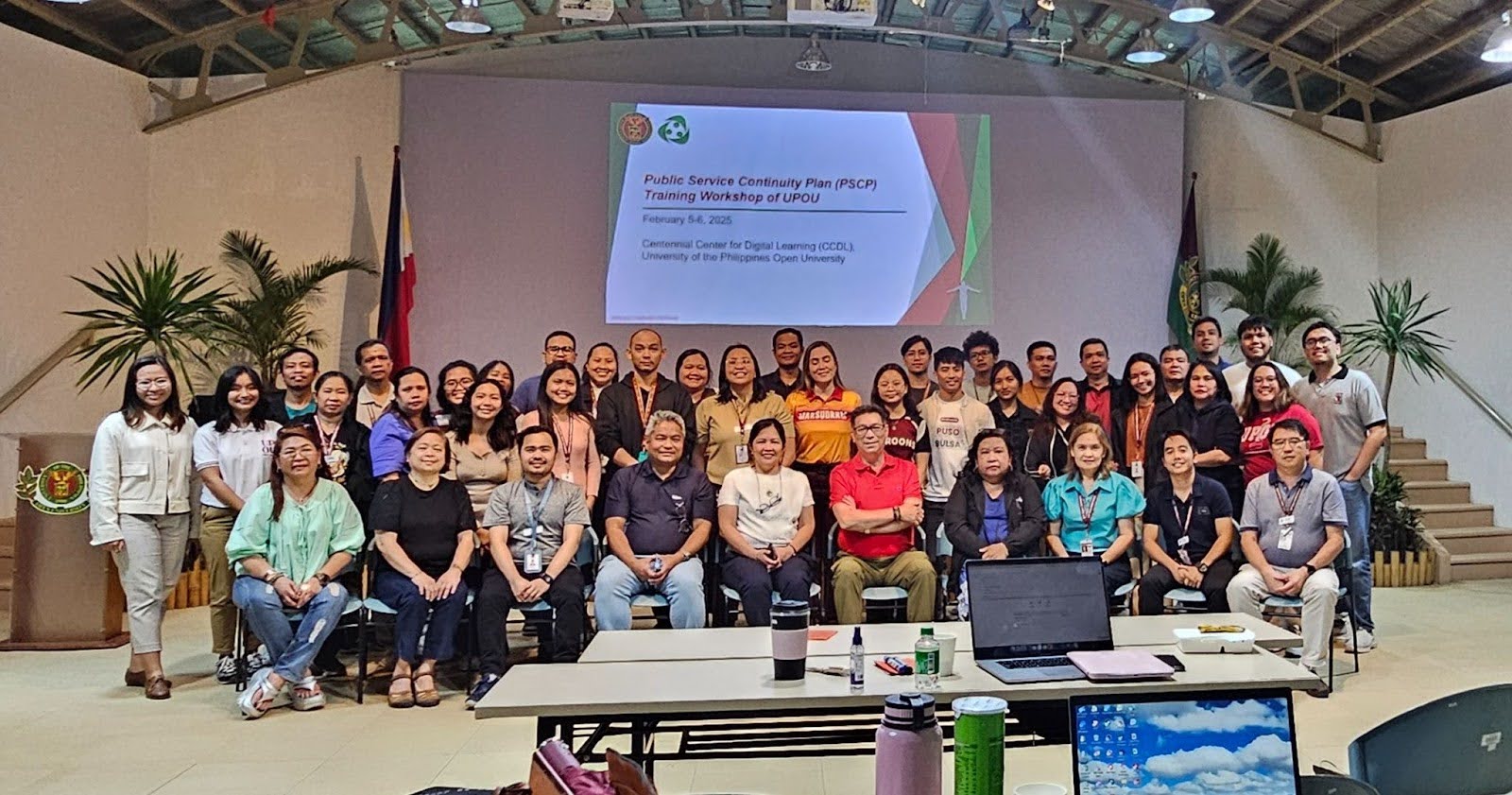On February 5-6, 2025, the UPRI Institution Building Division conducted a Public Service Continuity Plan Training Workshop for the University of the Philippines Open University (UPOU). Representing UPRI was IB Director Dr. Carlos Primero Gundran, IB Chief Science Research Specialist Jose Abraham Ongkiko, Junior Project Assistant Jerzyne Anne Corpuz, Franklin Joshua Gali, and Jonathan David Maligalig. The division was assisted by UP Manila DRRM-H Junior Project Assistants Trisha May Hilario, Aloyseus Sun Perez, Marinduque State University representatives Lenie Rodriguez and John Ray Mullinada. Held at the Centennial Center for Digital Learning of UPOU, the main purpose of this training workshop was to assist in the development of the university’s Public Service Continuity Plan (PSCP).
 Image 1: UPRI IB representatives conducting lectures for the crafting and development of the UPOU Public Service Continuity Plan
Image 1: UPRI IB representatives conducting lectures for the crafting and development of the UPOU Public Service Continuity Plan
The first official day of training began with an opening program, which featured a message from FMDS Dean Joane Serrano regarding the needs of the university’s existing PSCP. Immediately following this was the first lecture of the day, led by IB Chief Ongkiko wherein an in-depth lecture on the background and justification of the Public Service Continuity Plan was provided. Chief Ongkiko would detail the various concepts in DRRM such as the differences between hazards and disasters, the vulnerabilities of the Philippines, and how to calculate your capacities using a risk formula. Following this, Junior Project Assistant Franklin Joshua Gali delivered a lecture on Policy Building, focusing on the purpose, objectives, and scope of the PSCP. A workshop would then be conducted in the clustering and identification of said objectives using standards described in the lecture. Jonathan David Maligalig followed this with a presentation on the results of the UPOU’s rapid assessment last June 13-14, 2024. Mr. Maligalig identified key areas that required improvement and pinpointed the locations of hazards within the university.
 Image 2: UPRI conducts a Earthquake and Fire Drill at UPOU
Image 2: UPRI conducts a Earthquake and Fire Drill at UPOU
After lunch on the first day, a surprise earthquake and fire drill was conducted to test the university’s staff readiness. While common practices such as “duck, cover, and hold” were observed, it became clear that the staff involved lacked leadership structure. The absence of a clear chain of command and the failure to conduct a proper count-off highlighted areas where improvement was needed in UPOU’s emergency preparedness.
 Image 3: UPRI conducts a Workshop on Hazard Assessment and Identification at UPOU
Image 3: UPRI conducts a Workshop on Hazard Assessment and Identification at UPOU
Following this, Jerzyne Anne Corpuz then took the floor to lecture on Hazard Assessment and Identification, emphasizing the distinctions between natural and anthropogenic hazards. Following her lecture, Jerzyne led a workshop on hazard identification, where participants were tasked with rating the various hazards experienced on the campus. After a plenary discussion, it was determined that the top three hazards requiring focus were fire, flood, and cyberattacks, leading to a revision of their hazard assessment scoring.
The remainder of the day focused on identifying Mission Essential Functions (MEFs) and developing continuity strategies. Franklin Joshua Gali presented core concepts and conducted a workshop where the group laid out existing and potential MEFs for UPOU, analyzing continuity strategies for each identified function.
 Image 4: UPRI IB conducts the second day of lectures for the UPOU PSCP Training Workshop
Image 4: UPRI IB conducts the second day of lectures for the UPOU PSCP Training Workshop
The second day of training began with a lecture by Chief Ongkiko on the Incident Command System (ICS) and Incident Management Teams (IMT). The lecture described various roles within the ICS, and the group participated in a workshop to identify the specific teams and roles that would be relevant to UPOU in disaster scenarios. Jonathan David Maligalig then provided a talk on crafting a communication plan, which would outline the necessary mediums, strategies, and practices for effective communication during a disaster. Following this, Ms. Corpuz discussed the activation and deactivation criteria, highlighting the key triggers for initiating the Public Service Continuity Plan (PSCP). She highlighted the steps from activation—starting with assessment, resource mobilization, and communication—to deactivation, which involves evaluation, recovery, and the return to normal operations.

Image 5: UPRI IB and UP Manila DRRM-H Conduct a Fire Simulation Exercise
After lunch, the second day of training continued with a session by Chief Ongiko on basic disaster preparedness. This session covered practical knowledge such as the proper usage of whistles, hand signs, and essentials for a go-bag. Following this, IB Director Dr. Carlos Gundran conducted a simulation involving the UP Manila DRRM-H staff, where the ICS was practiced in a fire scenario. The simulation offered valuable insights into the strengths and weaknesses of UPOU’s current preparedness.

Image 6: UPRI and UPOU join in a group picture to conclude the two-day PSCP training workshop
The training concluded with a summary of the events and a commitment from the UPOU community to revise and improve their existing PSCP based on the lessons learned throughout the different lectures and workshops. For the way forward, it was agreed that the revised PSCP would go through two draft stages before finalization. UPOU will submit the first draft in the first week of April 2025, after which UPRI will review the draft and provide recommendations. Once the PSCP is endorsed by the Executive Director of UPRI and approved by the UP System, UPRI will conduct a simulation drill for UPOU to test the plan’s effectiveness.
